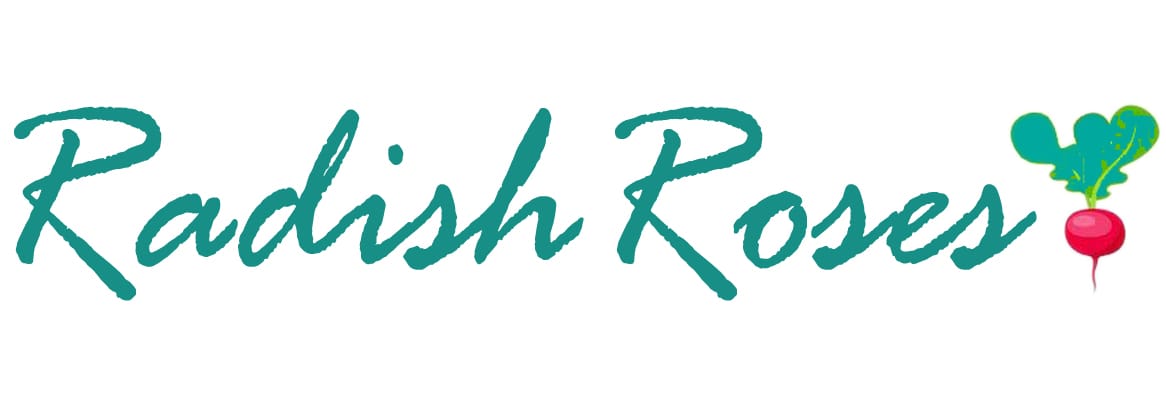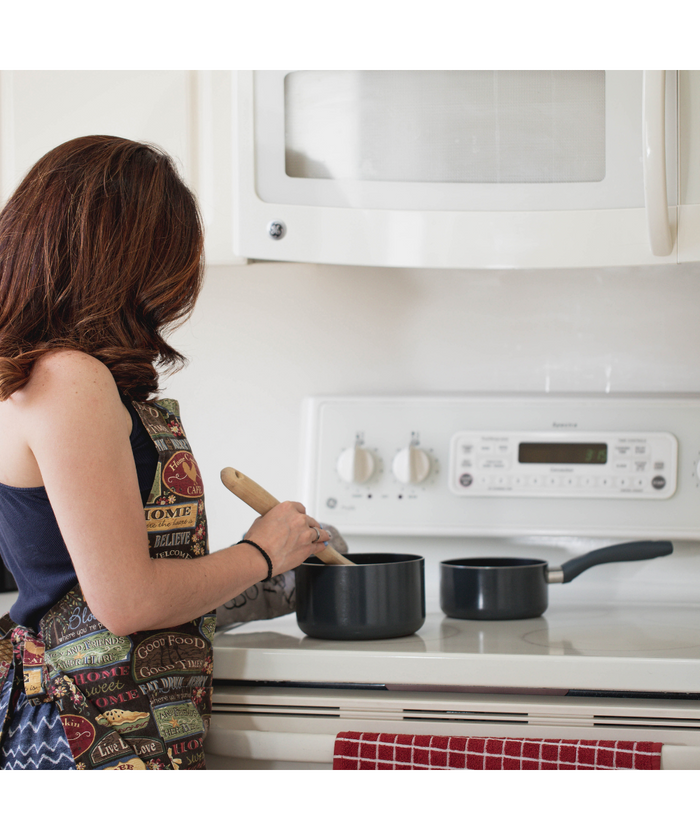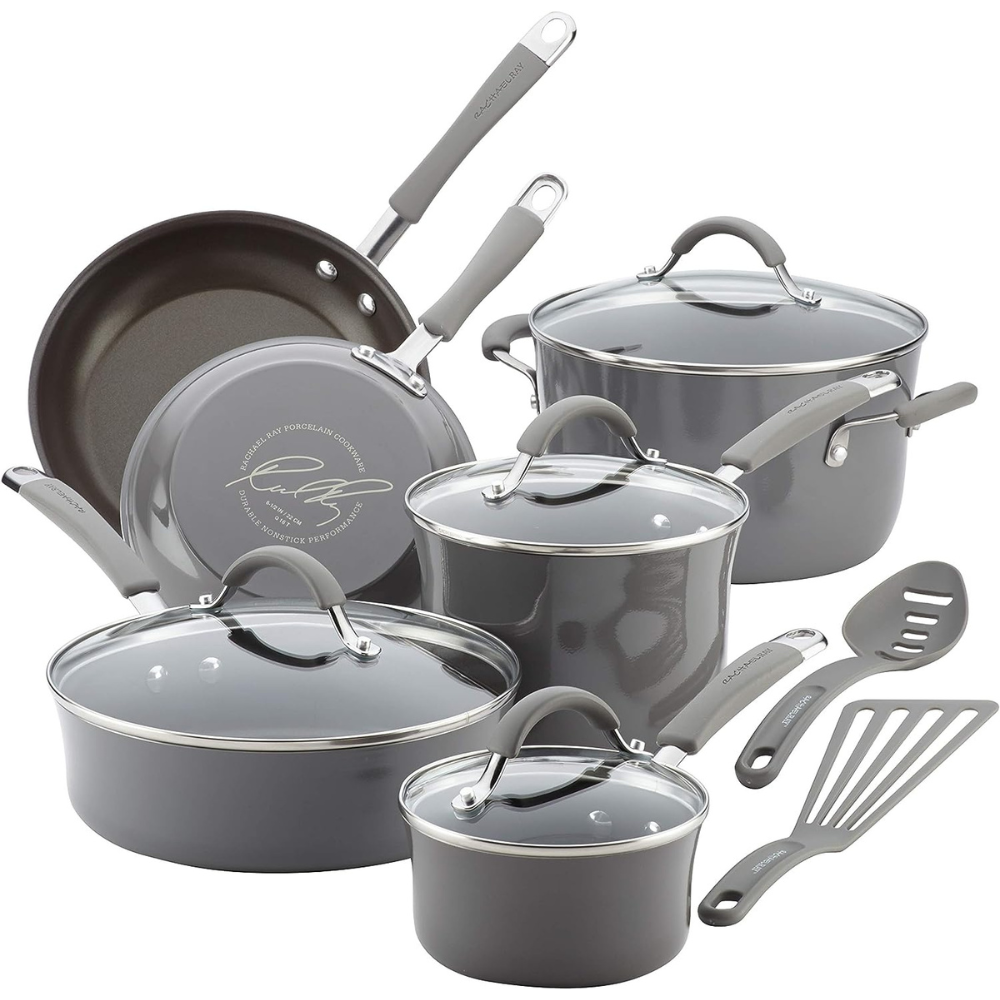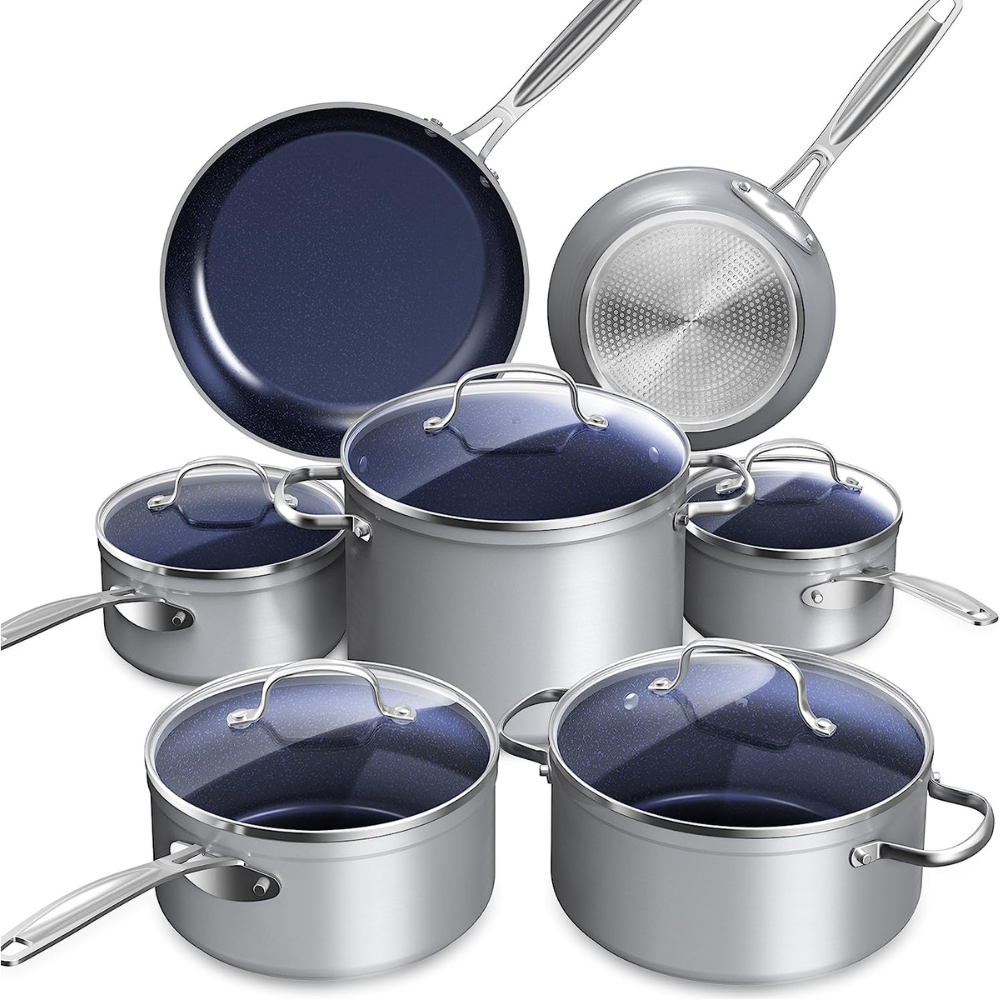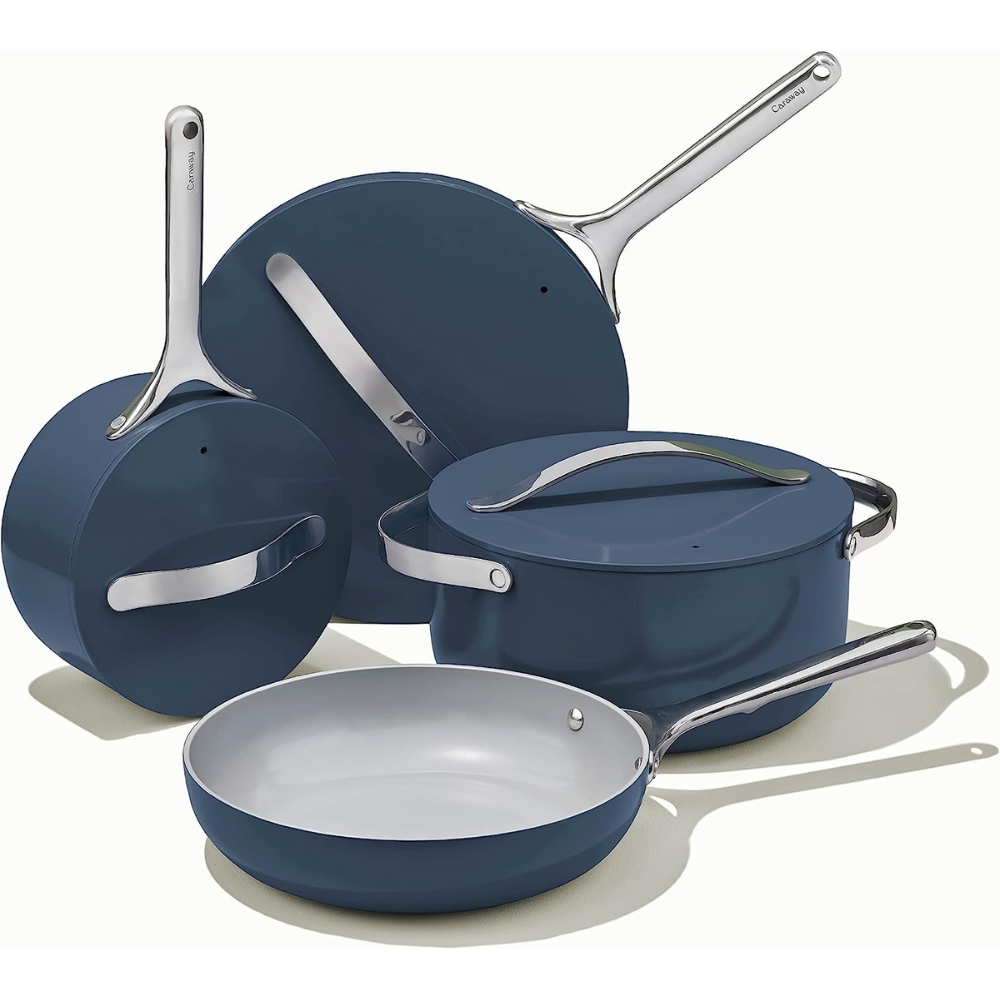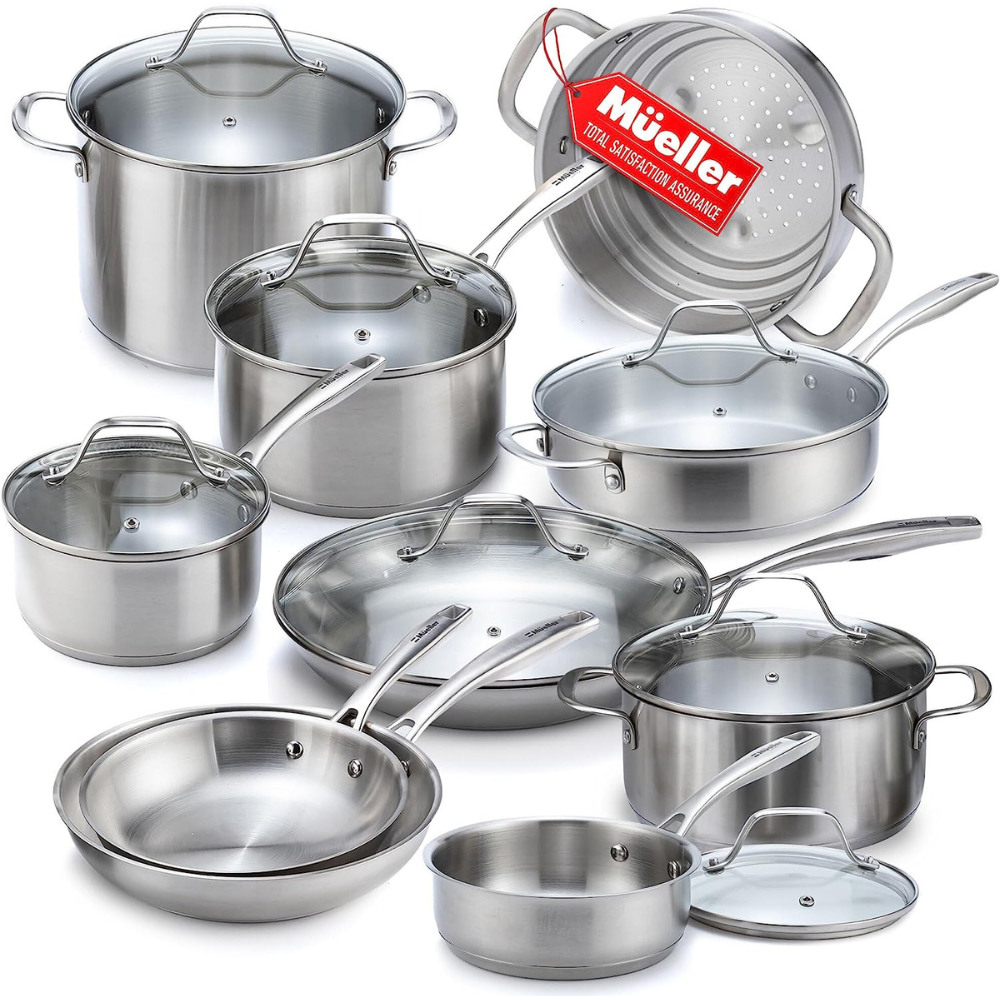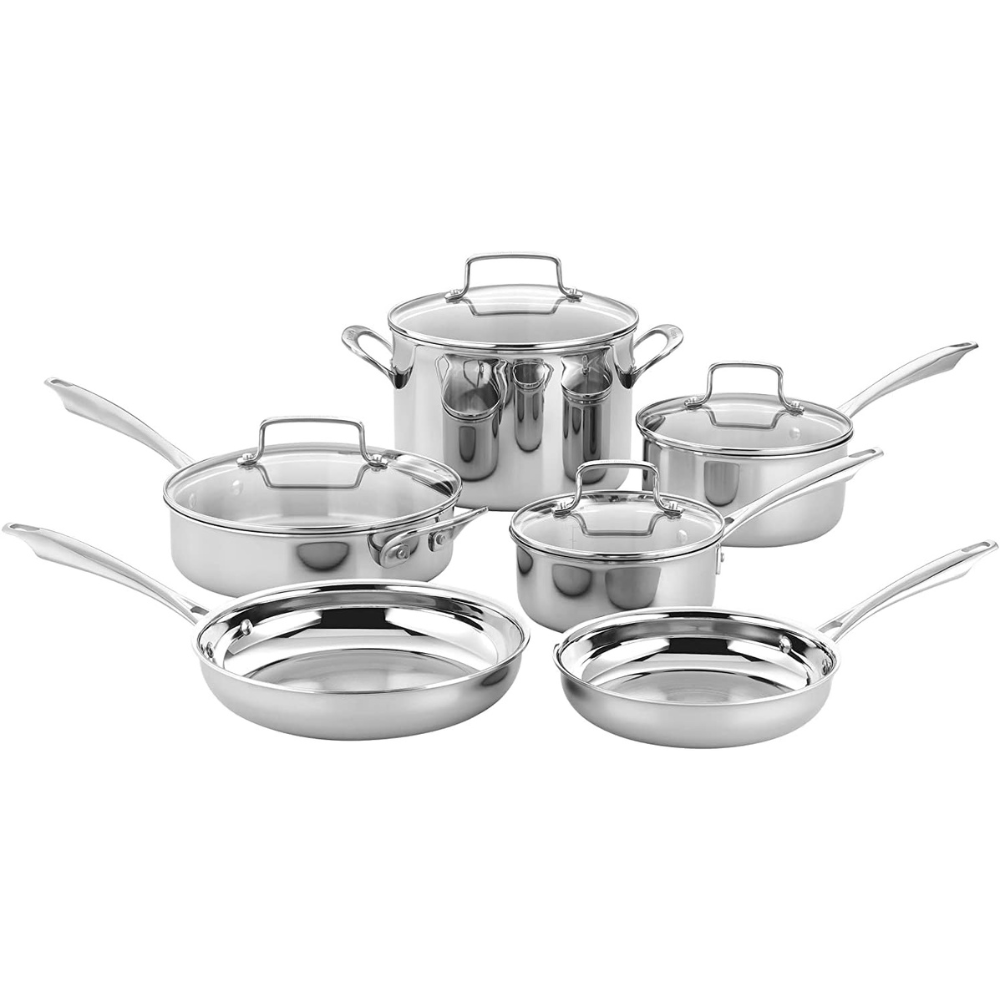Are you looking for the best pots and pans to cook with on your electric stove?
You’re not alone!
All stoves are not created equal! Electric stoves can be tricky when it comes to getting the right temperature, and if you use the proper type of cookware, you will be sure to get the best results.
In this article, we will review what we have determined to be the top pots and pans designed specifically for use on electric stoves so that you can find the perfect set for your kitchen as you cook food for your family.
From material composition and cooking surface, to handles and lids, we will explain why each cookware set makes a great choice. We hope this list will help you make the best decision about which set to buy when you cook on an electric stove.
These are some of the highest quality cookware sets available for use on electric stoves, in a variety of styles and prices. All are built with durable materials that will last through many meals as well as specialized designs tailored specifically to get amazing results from any electric stove!
You can finally stop wasting your precious time trying to figure out which are the best pots and pans for each job in your kitchen; these sets are not only ideal for electric stove tops, but have every size you need all perfectly matched up so they look great and are ready to cook food whenever you are.
So read on and get cooking - let's discover who has the best cookware for electric stoves!
What Are The Different Types of Electric Stoves?
You might be thinking, "how many types of electric stoves could there be? Why do electric stoves need special cookware?" Of course, electric stoves are, well, electric as opposed to gas stoves. In general, electric stoves conduct heat generated from electricity. Electric stoves include the following:
Electric coil stove: Electric coil stoves have been the most common type of electric stove since the 1950s. The electric coil stove features an electric heating element with coils that heat up and provide a consistent, even source of heat when cooking food.
Glass/ceramic cooktops: Ceramic cooktops are more modern and provide a sleek design to your kitchen. A relatively new type of stove, the glass top conceals the heating element beneath and an easy-to-clean smooth glass surface. Smooth top stoves require careful use and care to keep them beautiful. Cast iron cookware can be particularly problematic for glass/ceramic cooktops.
Induction: These are the newest type of electric stove in the market. The induction stove uses a magnetic field below the surface of the cooktop which heats up directly, making it much more efficient than traditional electric stoves. Like other smooth top stoves, induction stoves require special care to prevent cracking and scratching. Pots and pans that are compatible with induction stoves require conductive material like steel or cast iron. Hard anodized aluminum or copper cookware will not work on induction stoves. To create conductivity but still remain lightweight, many pans will contain an aluminum core. A thick aluminum core also promotes even heating and can keep production cost down.
Whether you prefer an electric coil stove, glass top stove, or induction, you can see that it really can make a difference which you use when deciding which electric stove cookware will be right for you.
Halogen: Halogen stoves are a hybrid between traditional electric coil and induction cooktops. They use halogen lamps to produce heat, which is then regulated by an internal thermostat. Halogen stoves have the same requirements as induction stoves in terms of the type of compatible cookware; they require metal pans with some kind of conductive material like steel or iron. Additionally, the pans should have a thick base for better heat conduction on halogen cooktops.
Our Review Process for Best Cookware for Electric Stoves
It can be tough to find the right cookware for electric stoves. It can be confusing to sift through the myriad of pots and pans on the market can be a huge hassle. The choice becomes even more confusing when you consider what cookware might be better to use with your specific type of electric stove.
Here at RadishRoses, we have reviewed thousands of ratings and consumer reviews of cookware suited specifically to work well with electric stoves to bring you this list of the best cookware for electric stovetops.
This convenient list of cookware is carefully curated and reviewed, allowing you to eliminate all the guesswork and find the best pots and pans for your electric stove quickly and easily.
We did not include any cast iron cookware in this selection. Cast iron is a very durable, safe and healthy option, and a favorite staple for many cooks. We feel cast iron cookware is generally not the best cookware for electric stoves. It can be particularly inconvenient with glass smooth top stoves because of their weight and potential for scratching.
The Best Pots and Pans for Electric Stoves
Rachael Ray - 16802 Rachael Ray Cucina Nonstick Cookware Pots and Pans Set, 12 Piece
What Stands Out:
- Rachel Ray is practically a household name
- her cookware is always a conversation starter
- this set comes in a variety of colors.
The Details:
Comes in 7 beautiful colors to express your personality, oven safe to 400 degrees, and nonstick coating* is PFOA free.
The cookware set has aluminum core for heat retention with a porcelain enamel coating, rubberized stainless handles, and glass lids. Suitable for gas and electric stoves.
It is a large set for a great price and has over 27,000 consumer reviews with very high ratings for value, even heat distribution, durability, and ease of cleaning.
Includes 1 and 3-quart saucepans and lids, 3-quart sauté pan and lid, 6-quart stockpot and lid, and 8.5-inch and 10-inch frying pans. All have smooth, flat bottoms that will work beautifully on glass top stoves, gliding easily across the glass surface without scratching.
There are several other sets of Rachel Ray cookware available that are also very good and might be an even better fit for your budget or other needs.
The Downside:
These pots and pans are not suitable for induction cooktops, and are not dishwasher safe (to protect the nonstick coating)
Nuwave Healthy Duralon Blue Ceramic Nonstick Coated Dishwasher safe Cookware Set with Tempered Glass Lids
What Stands Out:
Ceramic enamel coating is PTFE* free as well as PFOA free, not to mention the blue is really pretty!
The Details:
Fully clad stainless steel pots and pans with ceramic enamel coating is PTFE* free as well as PFOA free, harder and more durable than most PTFE or Teflon coatings, and is said to withstand high heat and is dishwasher safe.
Large 12-piece set, includes 1.5-quart, 2-quart, and 3-quart saucepans each with a glass lid, 5-quart and 8-quart stockpots with glass lids, and 8" and 9.5" frying pans. All have heat resistant, stainless steel handles.
This cookware set is great for gas stoves, electric stoves and has a stainless steel core that ensures superior heat retention to ensure food will cook evenly. The pots and pans are compatible with an induction stove, and oven safe to 500 degrees F.
The Downside:
Although the set is listed as dishwasher safe, it is usually recommended to hand wash your non stick cookware to make it last longer!
Caraway Ceramic Induction Cookware Set (12 Piece) Pots and Pans, Glass Lids and Kitchen Storage
What Stands Out:
- stylish brand that prides itself on quality details
- included magnetic cookware storage rack and canvas lid hanger
- small business
The Details:
Designer styling comes in a variety of colors to accent your kitchen. PTFE* and PFOA-free ceramic coating, that, unlike bare cast iron, does not require seasoning.
Includes 10.5" frying pan, 3-quart saucepan and 6.5-quart Dutch oven with stainless steel lids, 2 pots, 3 lids, and stainless steel handles. They also include a magnetic storage rack and canvas lid hanger.
Flat bottoms are great for smooth top electric stoves.
This cookware is induction ready, great on electric stove tops as well as gas stoves, and even oven safe to 550 degrees.
The Downside:
Higher priced set, not dishwasher safe (to protect the nonstick coating)
Mueller Pots and Pans Set 17-Piece, Ultra-Clad Pro Stainless Steel induction Cookware Set
What Stands Out:
- Contemporary classic stainless steel cookware set
- Dishwasher safe
- Large set for the price!
The Details:
Large stainless steel cookware set that has everything you need to cook on an electric stove like a pro.
Non-toxic, non-reactive stainless material withstands high heat for electric stove and oven-safe cooking. Dishwasher safe.
This stainless steel cookware set includes 1, 2, and 3-quart saucepans, 8", 10", and 12" skillets, 3.5-quart sauté pan, 4.5-quart Dutch oven, 8-quart stockpot and steamer, and comes with 7 tempered glass and stainless steel lids.
Hard aluminum core for even heating on an electric cooktop, glass top stoves, gas stove, oven-safe, and induction cooktop friendly.
The Downside:
Stainless steel cooking can take some getting used to compared to using nonstick cookware, so read the recommendations for proper use to get your best results!
Cuisinart Classic Pots & Pans Set, 10 pcs Best Cookware Set
What Stands Out:
Excellent consumer ratings for this beautiful, classic stainless steel set. Dishwasher safe.
The Details:
The cookware is PFTE-free* and non-toxic. Dishwasher safe, oven safe, and compatible with electric stoves, induction stoves, and gas stoves. They can be used on glass-top stoves.
Durable triple layer, hard aluminum core, stainless steel construction, even heat distribution, and oven safe. Stainless steel handles are heat resistant.
Includes 1.5 and 2.5-quart saucepans with glass lids, 3-quart sauté pan with glass lid, 6-quart stockpot with lid, and 8" and 10" skillets
This set has over 25,000 reviews with very high consumer ratings for durability, even heating, easy cleaning, and value for the money.
Be aware that stainless steel cooking can take some getting used to compared to using nonstick cookware, so read the recommendations for proper use to get your best results!
The Downside:
On the expensive end, but catch a sale and it will be well worth the cost!
Stainless steel cooking can take some getting used to compared to using nonstick cookware, so read the recommendations for proper use to get your best results!
*All darker, Teflon-like nonstick coatings (not ceramic) are made with PTFE (polytetrafluoroethylene-the main compound in Teflon), or some close variation, and should be used with care:
- do not allow the nonstick pan to reach temps over 500 degrees
- never leave the nonstick pan on a stovetop unattended, to prevent overheating
- only use silicone or other non-scratching utensils to ensure the coating remains intact and does not release particles into your food
- do not fry at high heat near birds, as they are particularly sensitive to even small doses of fumes that may be released at high temperatures.
Best Pots and Pans for Electric Stoves FAQ
Your Questions Answered!
Shopping for the right pot and pan set can be an overwhelming experience. With so many options on the market, it’s hard to know which one will provide you with the best value for your hard-earned money.
Here are some questions others have had regarding pots and pans for electric stoves. We hope you find some answers to any lingering questions you might have before making your final choice to buy.
Q: Are non-stick pans good for electric stoves?
A: Non-stick pans can be an excellent choice for electric stoves.
When it comes to cooking, nonstick pans can be incredibly helpful as they allow for minimal oil/ butter usage, which keeps food from sticking to the pan. This makes cleaning and flipping foods a lot easier.
Additionally, non-stick cookware distributes heat more evenly and efficiently than other types of electric stove cookware - reducing hot spots that occur on electric stoves where some parts may be hotter than others.
When using non-stick pans with electric stoves, make sure you don’t use too much high heat – do not use your highest settings!
High heat can cause the coating of your pan to deteriorate faster due to higher exposure levels- instead keep your temperature at medium or low when cooking on an electric cooktop.
Additionally, never use metal utensils. Only use silicone, wooden or plastic utensils when stirring and serving food to avoid scratching the surface of the pan.
Non-stick pans are also very versatile- as they are typically used for sauteing vegetables, frying meats and eggs, boiling water and even baking cakes!
The benefits of having just one type of cookware that is capable of producing such a variety of dishes cannot be understated!
So if you have an electric stove in your home make sure you invest in a good quality non-stick pan because it will save you time both during preparation as well as while cleaning up afterwards- making meal times much more enjoyable overall!
Q: Is stainless steel cookware safe?
A: Yes, stainless steel cookware is safe and a great choice for everyday cooking.
This type of cookware has been around for over a hundred years and is known for its durability, attractiveness and versatility.
It’s also non-toxic, as it does not interact with food or beverages in any way that would affect their taste or quality.
Stainless steel resists corrosion from acidic ingredients like tomatoes or vinegar while still providing an even heat distribution. Plus, stainless steel won't leach toxins into food like aluminum can do when heated to high temperatures.
Cleaning your cookware made from stainless steel is also easy to do by hand with just some regular dish detergent and warm water; it doesn't require any special cleaners or scrubbing pads which makes it much easier on the environment than other types of pots and pans.
Furthermore, in addition to being safe to use on electric stoves because of its inert qualities mentioned above, many people prefer stainless steel since it's resistant to scratching and denting (unlike some other metals such as copper cookware), so you don’t have to worry about replacing your pans often.
You simply need basic maintenance now and then such as wiping off any burnt residue on occasion with light scrubbing using a cloth dampened with soap water - something most kitchens already have available!
Finally, these types of pans are less expensive compared to other alternatives like cast iron, which require more intense cleaning care, making them overall more cost-effective too!
Q: Is Dawn dish soap safe for non-stick pans?
A: Yes, Dawn dish soap is safe to use on non-stick pans.
It is preferred that non-stick cookware be hand-washed to prevent the coating from breaking down over time.
The benefits of using a non-stick pan are many — they help minimize clean-up time and prevent food from sticking to the bottom of the pan.
However, any type of abrasive cleaner, such as steel wool or scouring powder, can cause damage. That's why you must use an appropriate cleaning method for your non-stick cookware.
Dawn dish soap is specifically designed for handwashing dishes and other kitchen items and has been proven to be highly effective in removing oils that accumulate on items such as pans and utensils.
Additionally, Dawn contains degreasers that break down the proteins that were used in manufacturing your pan’s non-stick coating — something more harsh cleaners cannot do without breaking down your coated surface over time.
- To ensure that your pan remains undamaged when washing with Dawn dish soap:
- Use a soft cloth or sponge while scrubbing – no scrubbers!
- Do not soak or leave lather on the pan for extended periods; rinse off immediately after applying the cleaning solution.
- If possible air dry rather than using heat from an oven or electric stove top.
By following these simple tips when cleaning your non-stick surfaces with Dawn, you can maintain their like-new condition for many years to come.
Q: Why do chefs only use stainless steel pans?
A: Chefs rely on stainless steel cookware for a variety of reasons.
One advantage is that stainless steel pans are extremely durable and long-lasting. Unlike most other materials used in cooking, stainless steel won't chip or crack if it's dropped or knocked around in the kitchen. They rival the best cast iron for durability, but are much lighter and are induction electric stove-friendly.
It's also corrosion resistant, meaning that it won't rust over time like some other metals like bare cast iron, aluminum or copper can do.
This makes it a great choice for busy cooks who don't have the time to replace their pans every few years.
Stainless steel has great heat conduction properties as well; this means that heat will spread evenly throughout the pan while you're cooking, minimizing hot spots which could cause food to burn on one side but not be cooked all the way through on another side. This makes stainless an excellent choice for electric stoves.
Additionally, many chefs appreciate how easy it is to keep clean after use; even food particles won’t get stuck and burned onto its surface when cleaned properly with warm soapy water and nonabrasive pads!
Plus, stains are often easy to scrub off without damaging the metal itself either, unlike certain non-stick coatings which can easily become scratched off by metal utensils or scouring pads.
Finally, stainless steel is one of those rare materials that look good even after lots of use – especially if a chef regularly polishes and maintains their cookware set!
All these features make stainless steel an ideal choice for professional chefs looking for reliable tools they can count on each day at work without having to break their budget replacing them often!
Q: What are the disadvantages of stainless steel cookware?
A: When it comes to the disadvantages of stainless steel cookware, there are a few key considerations that must be taken into account.
Stainless steel is an alloy made primarily of iron and chromium, as well as small amounts of other elements like nickel and carbon.
It's known for its durability and resistance to corrosion, making it an excellent choice for kitchen use and electric stoves.
However, there are still some drawbacks associated with stainless steel cookware that should not be overlooked.
One major drawback is that stainless steel lacks the non-stick properties of other materials such as Teflon or ceramic coatings; therefore food can easily stick to the surface if not cooked properly or cared for properly after use.
Another potential issue with stainless steel is that it can become hot spots when you cook food if the pans heat distribution is uneven due to improper cooking techniques; this could potentially cause overcooked food due to uneven high heat, especially when used on electric coil stoves.
Making sure you evenly heat your pots before adding any ingredients to ensure your food will cook evenly
Finally, because stainless steel is more rigid than other types of material used for cookware sets (such as aluminum), its heavier weight may make using larger pieces significantly more difficult during cleaning or transportation compared to lighter alternatives.
Despite all these drawbacks though, many people opt for stainless steel pots since they offer great strength and durability, and are made with cookware materials that have stood the test of time. The best stainless steel cookware will likely last much longer than the best cookware sets with nonstick cookware or aluminum pans.
Q: What is the best cookware to not scratch a glass-top stove?
A: When shopping for cookware to use on a glass cooktop, it’s important to consider a few key factors
The first factor is the material your pots and pans are made from—hard anodized aluminum, stainless steel, cast iron cookware, or copper cookware—since some materials are more likely to scratch than others.
Hard-anodized aluminum is one of the most popular options as its durable nonstick coating provides even heating and makes cleanup quick and easy; plus, it has a smooth finish that won’t scratch the surface of glass cooktops.
Also important in choosing cookware for a glass-top stove is the weight. Using a lighter cookware set, such as aluminum pans, helps reduce the stress placed on the glass top, while heavier ones, such as a cast iron pan, can create permanent scratches if they slide across the cooking surface of the glass cooktop.
Always take care how you handle or move those heavier pieces of cast iron cookware across glass cooktops; try using trivets when possible, as this will help protect against scratching caused by dragging that cast iron pan across the cooking surface without having an extra layer of protection between them and your appliance.
Q: Can you use a cast iron skillet on a glass-top electric stove?
A: Yes, you can use cast iron pans on glass-top electric stoves, but it must be done with care and caution.
Unlike aluminum cookware, cast iron skillets are heavy, so proper handling is necessary when handling them around glass-top stoves.
When using a cast iron skillet on glass-top stoves, place the pan carefully onto the stovetop. It is easy to underestimate the weight of the pan and dropping it down just right could easily crack the surface of your glass-top electric stove.
It is also important to know that cast iron has higher heat retention, so it's going to stay hot longer and may stress the cooktop if suddenly moved to a cool area of the glass top electric stove.
Finally – make sure never to slide your heavy pans across fragile surfaces; rather lift them off those tops carefully instead!
With these few precautions in mind, you can use your trusty and time-honored pans safely atop modern sensitive glass–topped electric stove!
Q: What is the best way to keep a glass-top stove clean?
A: Keeping a glass-top stove clean can seem like an intimidating chore, but it doesn't have to be. With the proper supplies and techniques, you'll find that cleaning your stove is easy.
The most important thing to remember when cleaning a glass-top stove is to always use specially made products designed for this purpose.
All you need is an abrasive cleaner specifically designed for glass tops, such as Cerama Bryte Glass-Ceramic Cooktop Cleaner or Weiman Glass Cook Top Heavy Duty Cleaner/Polish.
These cleaners will safely remove stubborn stains and cook spills from the glass top without damaging the surface of your appliance.
You may also want to invest in a nonabrasive cloth pad or microfiber towel—they're less abrasive than sponges or scrubbers, which could potentially scratch up the finish of your stovetop.
Next, spray some cleaner directly onto the surface before using your cloth pad/towel in circular motions over the flat cooking surface until all grime has been removed from its edges and corners.
If there are any particularly hard spots causing trouble (such as burned-on food remnants), try using a second soaked paper towel over those areas before applying more pressure with an extra bit of elbow grease.
Once everything looks shiny again rinse away any remaining residue with lukewarm water—taking care not to leave any excess liquid between ceramic plates! Finally, apply a thin layer of polish product afterward so that everything shines like new!
So Which Pots and Pans for Electric Stoves Are Right for You?
All in all, it's important to arm yourself with knowledge when investing in the best cookware set for electric stoves.
Not all metals react to heat differently and not all cookware sets are created equal. No matter what type of stove you may have, it's essential to keep these ideas in mind so you can get your money's worth.
We hope that our picks will provide you with valuable information on the top choices and trends out there.
Now that we've helped you narrow down your options, review your favorites and learn more by tapping the link below each selection!
